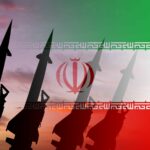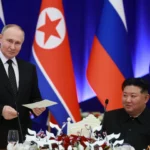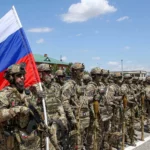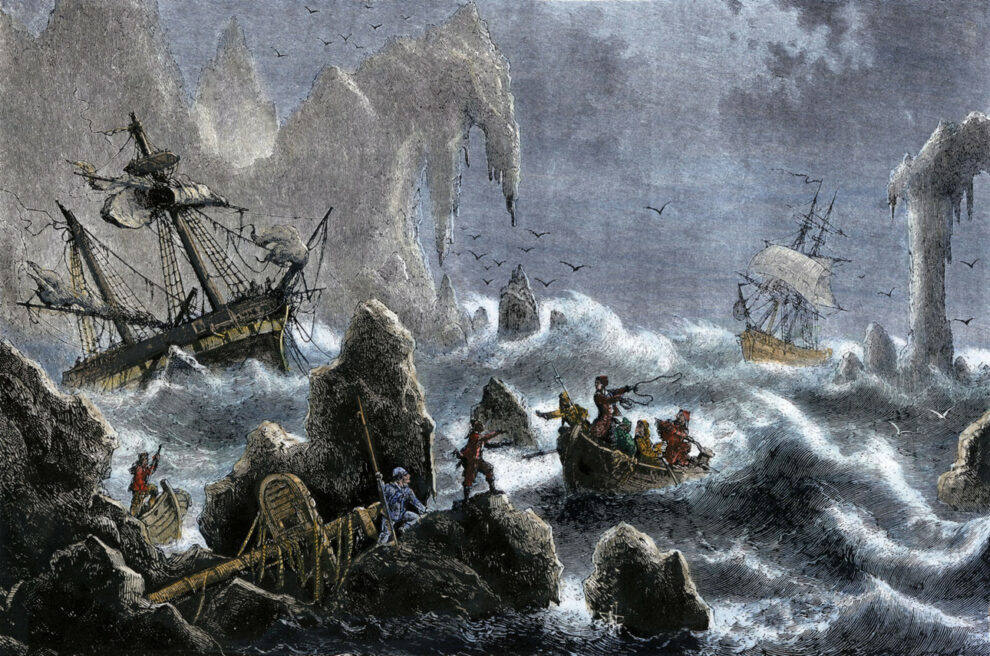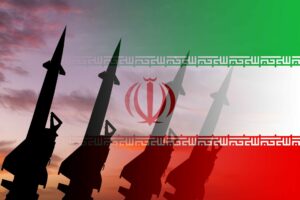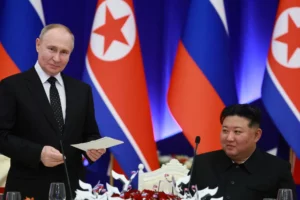In the racial-reckoning summer of 2020, local leaders in a small American town gathered for a contentious vote on whether to take down a statue that honored a man who was, as one assessment read, “steeped in racial division, violence and injustice.” Would they join local leaders from cities in Virginia, Alabama and other states to remove a memorial praising a figure who symbolized a “historical trauma” that still caused anguish and anger among their constituents?
The town council listened, and debated, and finally decided. By a margin of 6-1, the seven members voted to join the floodtide of decisions elsewhere to take down another symbol of historic oppression.
This statue, though, had nothing to do with the Confederacy or the Civil War. Rather, this vote took place in Alaska, in the small coastal town of Sitka (population 8,400), located on an island about halfway between Anchorage and Vancouver, British Columbia. And the statue was of a Russian, a merchant by the name of Aleksandr Baranov, a key figure in Russia’s conquest of Alaska over 200 years ago. The resolution authorizing the removal said Baranov, who was Alaska’s first colonial governor, “directly over[saw] enslavement of Tlingit and Aleut people,” a policy that was “often justified under a theory of racial and cultural superiority.” Baranov’s criminality — which included, among other things, the “violation of Native women” and “murder and theft of Indigenous property” — was so depraved that local Tlingit nicknamed him “No Heart.”

The removal of Baranov’s statue never cracked into the national news cycle. And maybe that’s understandable, given the protests rocking the rest of the country at the time. But it’s also understandable for a related reason: Russia’s colonization of Alaska — and the rampant violence, spiraling massacres and decimation of local Alaska Native populations that came along with it — is hardly well-known among the broader American body politic. Even with new reassessments of European colonization of North America, as well as the recent spike in scholarship regarding the U.S.’s bloodied imperialism across the American West, Russia’s role in smothering and seizing Alaska stands apart as an overlooked chapter of colonialism on the continent.
It’s also an overlooked aspect of Russian history inside Russia. Official accounts of Russian expansion suggest that Russia simply agglomerated neighboring peoples as part of its defensive acquisition of territory, happily gathering new peoples and new lands into Moscow’s embrace. In Russia’s telling, the word “colonialism” applies to only other empires, not to the Russian one. As Foreign Minister Sergei Lavrov recently claimed, Russia has “not stained itself with the bloody crimes of colonialism.”
But as the removal of Baranov’s statue indicates, Russia’s colonial legacy is hardly forgotten in Alaska. And given Russia’s renewed lurch toward imperialism in places like Ukraine, that legacy is arguably more resonant now than it’s been in decades — or perhaps ever.
In Western universities and research institutes, Russia’s invasion of Ukraine triggered a sweeping reassessment of Russia’s relationship with other peoples and nations, including Ukraine. For decades, Western scholars saw the Soviet Union as a fundamentally different country from the Russian Empire that preceded it, and analyzed its system and behaviors primarily through the regime’s communist ideology. As such, when the Soviet Union collapsed, many in the West assumed that once Moscow had shed communism, democracy would naturally follow.
But post-Soviet Russia has turned out differently, and both inside and outside Russia, scholars and analysts are discerning important throughlines in patterns and practices from tsarist times to the present. One of those throughlines is colonialism, which is turning out to be one of the best explanations for Russia’s aggression against Ukraine.
Which is why it’s past time for Americans to finally familiarize themselves with the Russian occupation of Alaska, and with what it meant for not only Indigenous populations slaughtered and shattered by tsarist forces, but for how that history reframes our understanding of Russia as a colonial power little different from its European counterparts — especially here, in North America.

The story of Russia’s imperial designs in North America traces to 1741, when explorer Vitus Bering first sighted Alaska’s Aleutian islands. At the time, Bering was searching for proof of a reputed “Great Land” that lay to Siberia’s east, a semi-mythical outpost of untapped wealth that could enrich his benefactors back in St. Petersburg. There was nothing defensive, or even natural, about Russia’s expansion into Alaska across the northern expanse of the Pacific Ocean. It was predicated on one thing alone: wealth, which could be stolen from whomever they might meet in Alaska.
While Bering wouldn’t live to explore this “Great Land” — he perished soon after, undone by scurvy — his shipmates quickly realized that the rumors of unbound wealth, in the form of a flood of fur, were true. Just as Russian troops and trappers had scoured Siberia for riches like sable pelts (dubbed memorably as “soft gold”), Alaska proved a bounty of fox fur, as well as seal and otter pelts. Hundreds of thousands of skins soon began flowing westward, adding to the coffers of tsarist patrons in St. Petersburg.

Of course, it wasn’t Russian sailors themselves who were clubbing or shooting each of these animals. The Aleutian Islands, and much of the southern rim of Alaska that Russian shipmen explored, already housed tens of thousands of locals. Aleuts and Tlingits, Inuit and Yupik, nation after nation of Alaska Natives already claimed a home in the region, largely untouched by European explorers.
And then the Russians came. And just as they had among Indigenous peoples in Siberia — and just as British, French, Spanish, and Portuguese explorers had done in the warmer climes of the Americas — Russian troops saw Indigenous peoples as little more than a subhuman hindrance, but also as a potential means to an end.

It didn’t take long after the Russian landing for the familiar pattern of colonial crimes to play out, sending Indigenous populations reeling. Almost immediately, Russian colonizers began implementing the same playbook they’d perfected across Siberia. The first step was known as iasak, in which Russian representatives demanded tribute — furs, typically — from Indigenous populations. In order to assure compliance, Russian traders implemented the playbook’s second element: amanaty, in which Russians would seize hostages from Indigenous populations, held until the iasak requirements were completed. Often, Russian representatives would kidnap the children of local leaders — all the better to ensure compliance. In some cases, as historian Anne Hyde has written, the Russians would abduct the children of up to half of the male populations of a given community.
Nor did they stop there. As the U.S.’s National Institute for Health notes, such an arrangement allowed the Russians to effectively “enslave” local populations. Demanding “furs in exchange for [the] lives” of women and children, Russians would “sexually exploit the hostages” — and even “execute the hostages” should the fur intake fall short. All of it, just “to set an example” for other recalcitrant Indigenous populations.
For much of the 18th century, Russian rule in Alaska was largely driven by trappers and traders, diffusing across southern Alaska without any real organization. But a few decades after first contact, tsarist officials formally chartered the Russian-American Company to bring some order to Russia’s shambolic conquest. Modeled on private companies elsewhere, not least the British East India Company in South Asia, the RAC was a nominally independent entity, granted the right to expand and entrench Russia’s colonial holdings.
Backed by the Russian navy, the RAC’s expansion wasn’t difficult, sending employees across the broader Alaskan landmass, and even exploring farther south along the Canadian and American Pacific coasts. And at the helm of the company was one man: Baranov, serving as the first formal governor of Russian Alaska — and a man who, as one Alaskan said in 2020, was “responsible for murder, enslavement, rape and a perpetrator of genocide,” all on behalf of a distant tsar.

Few nations suffered more under Russian rule than the Aleuts. Battered by both iasak and amanaty systems, Aleut populations went into immediate decline. But they hardly stood passive. By the early 1760s — just as British forces elsewhere on the continent began implementing new, and wildly unpopular, taxes on American subjects — Aleut men across the larger islands covertly gathered and plotted how to kill all the Russians. And at first, they succeeded. Far more familiar with the crannies and inlets of the Aleutian archipelago, Aleut men picked off wayward Russian invaders. Later, estimates placed Russian fatalities at nearly three dozen. One Russian ship attempted an escape, but was flung back by waves onto the shore, where Aleut infantry killed dozens more stranded Russian castaways.
Russian retaliation was, unsurprisingly, swift. One Russian captain, Ivan Solovyev, immediately unleashed a policy veering close to — and potentially into — genocide. Russian observers related how Solovyev began killing dozens of Aleuts where he found them, murdering them “on the spot” amid “terrible” bloodshed, writes historian Claudio Saunt. After 300 other Aleuts hid in a “fortified structure,” Russian observers later remembered Solovyev detonating the building, butchering the remainder “with guns and sabers.” As Saunt added, Solovyev reportedly “practiced a cruel experiment: arranging the Aleuts in a line, he fired at the first to discover how many people the bullet would pass through. … The slaughter was so atrocious that the sea around [one island] became bloody from those who threw themselves or were thrown into it.”

The total number of Aleuts killed remains unknown, but one Russian observer estimated that Solovyev alone oversaw the massacring of over 3,000 Aleuts. Given that there were only 17,000 inhabitants of the Aleutian Islands upon the Russian arrival, Solovyev may have been largely responsible for the annihilation of nearly one-fifth of the entire Aleut nation. Whatever the final number, Solovyev’s rampage was, said historian Katherine Johnson Ringsmuth, “the beginning of the end of [Indigenous] sovereignty.”
But Solovyev was far from the only Russian guilty of mass slaughter. Not long later, near Alaska’s massive Kodiak Island, Russian colonizers shelled fleeing Alutiiq men, women and children sheltering on the appropriately named Refuge Rock. Aiming cannonade at the defenseless Alutiiqs, the Russians “carried out a terrible bloodbath,” one Alutiiq elder later remembered, with “the stench of the corpses lying on the shore [that] polluted the air so badly that none could stay there.” Hundreds died — some shot, some flinging themselves into the sea from nearly 10 stories up. Other remembrances place the number of deaths even higher, reaching into the thousands. And all of it, without the Russians suffering a single casualty.
As one archaeologist later said, the Russian massacre at Refuge Rock – which took place just a year after American forces had finally completed their revolution against the British — “was the Wounded Knee of Alaska.”

The comparison is, in many ways, an apt one — and one that should help Americans, as well as Russians, more accurately understand Russia as a colonizing power, both then and now. Much like Wounded Knee — in which American soldiers slaughtered hundreds of prone Lakota men, women and children — Russian troops likewise liquidated hundreds of Indigenous civilians. Much like Wounded Knee, the people of Refuge Rock had already been stripped of both land and rights, subsumed into the colonial maw of an expanding empire. And much like the realities of Wounded Knee, whitewashed by later American propagandists, the actual details of the Refuge Rock massacre had been for centuries, as one newspaper report described, “forgotten.”
But where Wounded Knee has seen both new relevance and interest, events like Refuge Rock, as well as the broader crimes of Russian colonialism in Alaska, have been largely ignored. Part of that is general ignorance across most of America about Alaskan history, which is largely limited to trivia like the date the U.S. purchased Alaska (in 1867, after over a century of Russian colonial control). And part of that is a complete unwillingness in Russia to even gesture at Russian colonialism, let alone take any responsibility for Russians’ genocidal crimes, in Alaska and elsewhere.
Yet even aside from Alaska, the record is clear that Russia engaged in colonial conquest and exploitation from the earliest days of the tsarist empire. For hundreds of years, tsarist forces launched any number of colonial campaigns along its outer reaches, decimating neighboring powers and transforming them into tributaries of wealth for the Russian state. Toppling governments, slaughtering local populations, unleashing genocidal violence on many of those who opposed the expansion of Russian state power — Russia’s spread mirrored the stories of colonial conquest elsewhere. Indeed, like Spain in South America or Britain in South Asia, much of Russia’s expansion was driven not by national security concerns, but by efforts to grab and strip as many resources as Russian forces could find.
This is especially true in Alaska. After all, in Alaska, the propellant for expansion was glaringly obvious. You cannot argue that Russia needed to conquer Alaska in a search for territorial security, for so-called strategic depth that put distance between tsarist forces and any enemies. There was only wealth to be extracted — furs to be found, pelts to be culled, all as part of the “most important source of imperial revenue” for patrons in St. Petersburg. As seen with British brutality in places like Nigeria, or Belgian horrors in Congo, or French violence in Vietnam, Russia’s raison d’etre in Alaska was simple: pure, rote colonialism, dedicated to extracting wealth, entrenching Russian forces, and decimating an Alaska Native population that has only recently recovered to pre-Russian numbers.
Indeed, Alaska remains arguably the clearest case study in Russian colonialism available. While debates continue to surround Russian expansionism elsewhere — and where, exactly, the lines between Russian imperialism and Russian colonialism may lie — there’s little debate about what dragged tsarist forces to Alaska.
Russia, after all, never evinced any interest in actually settling Alaska. Russian nationals remained largely limited to Alaska’s southern rim, often using its bases there for further ventures in the Pacific Northwest, California, and even Hawaii. There’s little evidence tsarist powers had much interest in actually governing Alaska as a constituent part of the empire. Even after a century of Russian control, by the time Tsar Alexander II offloaded Alaska to the U.S., fewer than 500 Russian settlers actually lived in the territory.
Russian forces appeared interested solely in stripping Alaska of its bottomless wealth, and using and abusing Alaska Native populations for whatever they needed. Contra Lavrov, Alaska illustrates that Russians were motivated by unalloyed colonialism, and were willing to resort to the most brutal methods necessary to suck as much wealth out of Alaska as they could find. In the 18th century, Russia conquered much of the Eurasian continent, eventually controlling lands from the Black and Caspian seas in the south to the Arctic in the north to the far eastern Pacific coast, and subjugating dozens if not hundreds of Indigenous nations, including Buryats, Chechens and Tatars. But it was in Alaska that Russia’s colonialist drives reached its apex. And it was Alaska that highlighted just how similar Russian expansionism was to European colonial projects elsewhere.

Yet that reality remains largely unknown, and largely unexamined, even in the U.S. It’s only this year that the largest North American association of Russia scholars decided for the first time to focus on “decolonization” as a topic of its annual conference — some 75 years after the association was first formed. Such a lack of interest is that much more astonishing when you realize that Russia, in Alaska, colonized nearly 20 percent of the U.S. itself — a larger land-mass than the size of the 13 British colonies that first declared independence.
Thanks to that myopia, a sprawling blank space remains in our understanding not only of Europeans’ colonial cruelty in North America, but also in our framing of Russia as a colonial power, indistinguishable from Britain or France or Spain or elsewhere.
If the awareness of Russian colonial crimes in places like Alaska were better known, and better digested in the broader American body politic, events like the Ukraine invasion — and the colonial underpinnings of such brutality — would be far less shocking. As historian Timothy Snyder has argued, Moscow has long viewed Ukraine through a thoroughly colonial gaze, and is now helmed by a dictator who is trying to not only seize Ukrainian provinces but who is dedicated to Ukraine’s “national extinction,” with all of it “represented by Russian colonialism.”
To be sure, there are clear differences between Russia’s misadventures in Alaska and its ongoing efforts in Ukraine. Russian President Vladimir Putin, for instance, has routinely described Ukrainians and Russians as “one people,” but there were never any gauzy myths about the sameness of Russians and Alaska Natives. (As Saunt wrote, Russian invaders routinely dehumanized Indigenous Alaskans, describing the “filth” of people who “live their life just like animals.”) Likewise, Alaska never played a central role in Russia’s broader identity; while Russians claim Ukraine as a core, constituent part of Russia proper, there is no similar view of Alaska (for most Russians, at least).
And yet, even with those differences, the similarities amidst Russia’s colonial campaigns are increasingly inescapable. In Alaska, Russian colonizers adopted a specific policy of trying to “subdue [Alaska Natives] into citizenship of the Russian Empire” — an identical policy currently playing out in Ukraine. In Alaska, Russia imported proxy politicians to oversee conquered local populations — just as we’ve seen in Ukraine. And in Alaska, Russian colonizers remained convinced of their rightness, of their rectitude, and of their rampant abilities to seize as much territory and as many people as they’d like on behalf of their imperial leaders — just as we’ve seen from an increasingly messianic Kremlin.
But it is perhaps in the similarities to other European empires that Russia’s conquest of Alaska can be the most instructive. After all, Russia was hardly the only, let alone the first, European colonial power clawing apart North America. In many ways, it wasn’t even unique; if anything, many of Russia’s policies in Alaska were identical to other European colonial campaigns in North America (and elsewhere). There was the outright enslavement of Indigenous Alaskans, identical to Spanish mission-led enslavement of Indigenous Californians. There were the massacres of unarmed Alaska Natives, identical to the English slaughter of Pequot or French butchering of Fox. And there was, all throughout, the Russian conviction of moral, even spiritual, virtue to the entire colonial experience — indistinguishable from, say, American imperial expansion across North America, and even into Alaska. “Russia was no less a colonial empire than any of the other Western European powers,” Mikhail Khodarkovsky, one of the leading scholars on Russian colonialism, has written. “Russia had been imbued with its own sense of manifest destiny since the late 15th century.”
And it is that “manifest destiny” that now plays out in Ukraine. As Putin has claimed, Russia is not simply another nation, but is a “state-civilization” that, as analyst Andrei Kolesnikov wrote last year, has “a special path” laid before it, all part of the Russia’s “thousand-year history.” (As Lavrov reportedly said, Putin “has three advisers: Ivan the Terrible, Peter the Great and Catherine the Great.”)
And that status as a supposed “state-civilization” means that Russia has a right — or a destiny, if you will — to absorb and dominate its former imperial holdings. Putin repeatedly insists Russia must be recognized as a “great power.” But that formulation by definition means Russia must be dominant over other peoples and exercise power over a range of other nations. Per Putin’s logic, Russia cannot be a great power without “subject” nations that prove its dominance. And so Ukraine — arguably its oldest, as well as geographically and culturally closest, colony — could not be allowed to escape Moscow’s grasp.
It now seems obvious that Russia’s monomaniacal obsession with empire drove it to invade Ukraine. And it was an unwillingness or inability to view Russian expansionism — either then or now — as colonial in nature that blinded so many in the West to Moscow’s actual designs. Unless the West grapples with this history now, the threat Russian imperialism still poses cannot be countered.
Thankfully, that recognition of Russian colonialism is finally happening. But it’s decades overdue. And it’s that much more unfortunate that all along, we had a clear case study of the phenomenon — and the costs, and the legacies — right here, in America. All we had to do was look.
Source : Politico


